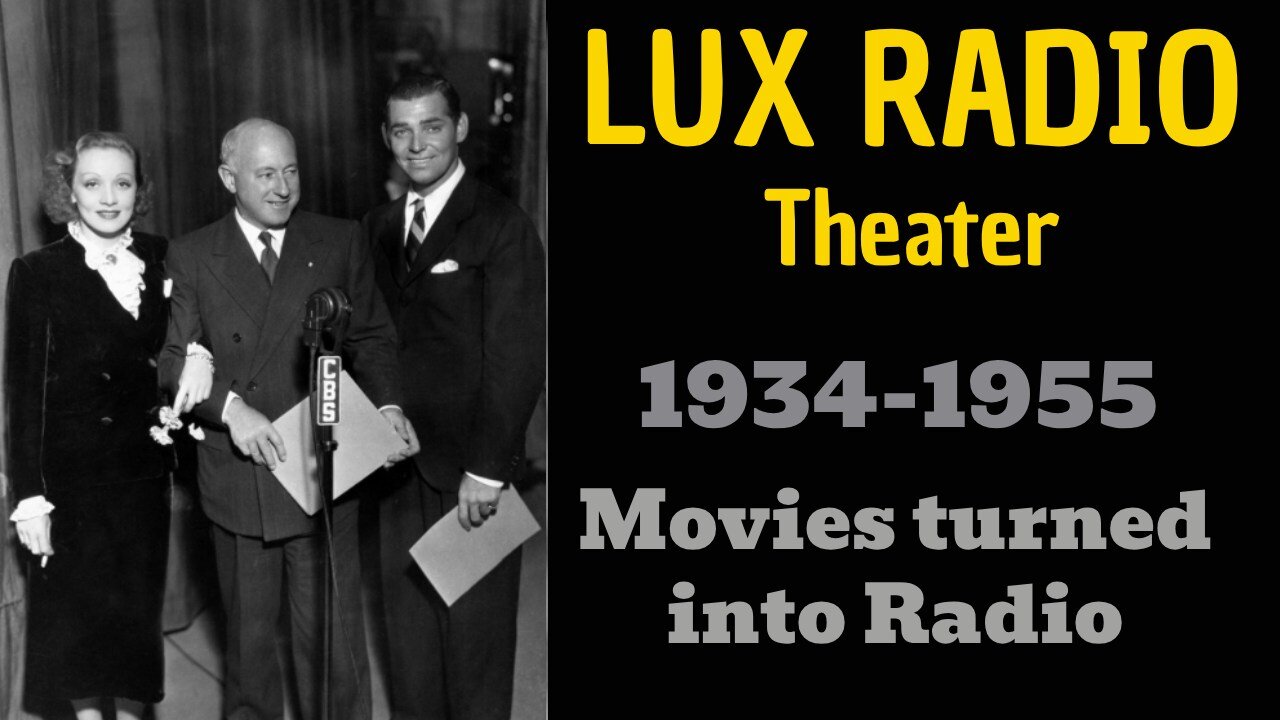Premium Only Content

Lux Radio 43-07-05 (ep403) My Sister Eileen (Rosalind Russell, Janet Blair)
American comedy film
Plot
Anxious to help boost the career of her aspiring actress sister Eileen, reporter Ruth Sherwood of the Columbus Courier writes a rave review about her performance in a local play before it opens. When Eileen is replaced on opening night and the newspaper mistakenly runs the inaccurate review, Ruth is fired.
Grandma Sherwood urges Ruth to move to New York City and Eileen decides to go with her. Relying solely on $100 given to them by their father Walter for financial support, the girls are forced to rent a dingy basement studio apartment in a Greenwich Village building owned by Mr. Appopolous. Their first day there is disturbed by workmen blasting to build a subway tunnel, passing drunkards harassing them through their windows, and Officer Lonigan, who warns them to stop causing disturbances.
Lux Radio Theatre was indisputably the biggest, most important, most expensive drama anthology program on radio. It ran from October 14, 1934 until June 7, 1955, then continued on television as Lux Video Theatre until 1957. In all, some 926 episodes were broadcast, providing a record of the most important entertainment events in American theatre and, later, film.
The show was first broadcast on the NBC Blue Network on Sundays at 2:30 PM. The show featured adaptations of successful Broadway plays when it was produced out of New York, such as Seventh Heaven, the first production starring Miriam Hopkins, Smilin' Through, Berkeley Square, Daddy Long Legs, Peg O' My Heart and Way Down East. On July 29, 1935, the show moved to Monday night at 9:00 PM on CBS, where it would stay until June 29, 1954. The show moved to Hollywood on May 25, 1936 with the production of The Legionnaire and the Lady, based on the film Morocco, starring Marlene Dietrich and Clark Gable. The audience for this production was estimated as high as 40 million. The show featured many of the most important films of the period, adapted to fit the 60 minute time slot. Some of the titles for 1939 should indicate the caliber and range of shows: Stage Door, Ceiling Zero, So Big, It Happened One Night, The Lives of a Bengal Lancer, Lady for a Day, The Life of Emile Zola, Tovarich, Only Angels Have Wings, The Prisoner of Zenda, The Awful Truth, Wuthering Heights, You Can't Take It With You, The Old Maid and Goodbye, Mr Chips. For its last season, (1954-1955), the show moved to Tuesday nights at 9 on NBC.
Lux Radio Theatre was always broadcast live, with a studio audience and a full orchestra accompanying the performance and providing musical transitions between scenes. As many film actors were used to numerous takes and not live performance, they sometimes suffered acute stage fright before the show. However, since most received $5,000 for their performance -- in addition to free publicity for upcoming pictures -- actors appeared in their original screen roles if they were available. Indeed, production would halt if necessary, on a film if performers were called to appear on Lux. When the actors were not available, others stepped in. The plays were assembled and rehearsed for a week, in sharp contrast to many other shows, which required a minimal of an actor's time. Regular players for the series included Jim and Marian Jordan, otherwise known as Fibber McGee and Molly. Hosts included Cecil B. DeMille (1936-1945), William Keighley (1945-1952) and Irving Cummings (1952-1955). Directors included Tony Stanford, Frank Woodruff, Fred MacKaye and Earl Ebi.
-
 50:01
50:01
Ben Shapiro
2 hours agoEp. 2154 - Stephen A. Smith ATTACKS Me!
40.2K23 -

Simply Bitcoin
2 hours ago $2.19 earnedBITCOIN CRASHED TO $78K: This Is When You Buy The Dip!! | EP 1199
28.9K1 -
 1:57:57
1:57:57
The Charlie Kirk Show
2 hours agoPardon Derek Chauvin + Buh-Bye, BLM + Destroy the Deficit | Sen. Scott, Ben Shapiro | 3.10.25
88.4K37 -
 58:52
58:52
The Dan Bongino Show
5 hours agoThe Left Can't Meme And Can't Win (Ep. 2438) - 03/10/2025
667K1.39K -
 1:01:32
1:01:32
The Rubin Report
4 hours agoTrump Addresses Rumors of Elon Musk & Rubio Clashing in Cabinet Meeting
64.7K32 -
 2:09:05
2:09:05
Steven Crowder
6 hours agoTrudeau Out, Carney In: Who Is Canada’s Anti-Trump Puppet?
453K249 -
 1:04:31
1:04:31
Timcast
5 hours agoDemocrat Machine IMPLODING, Biden AUTOPEN Scandal & ActBlue's COLLPASE Signal END Of Deep State
115K133 -
 1:49:52
1:49:52
Benny Johnson
3 hours agoTrump Orders BLM Plaza DISMANTLED in DC, DHS Launches DEPORTATION App | Secret Service KILL Gunman!?
126K73 -
 1:02:07
1:02:07
Kyle Fortch
5 hours ago $0.40 earnedOllie Joseph: 100,000,000 Streams Organically & The Creation Of "Mountain Pop" | THE ONE SHEET S1E7
15.8K -
 16:47
16:47
T-SPLY
7 hours agoDemocrats Keep Pushing For A Government Shutdown In A Historically Dumb Move
12.4K9